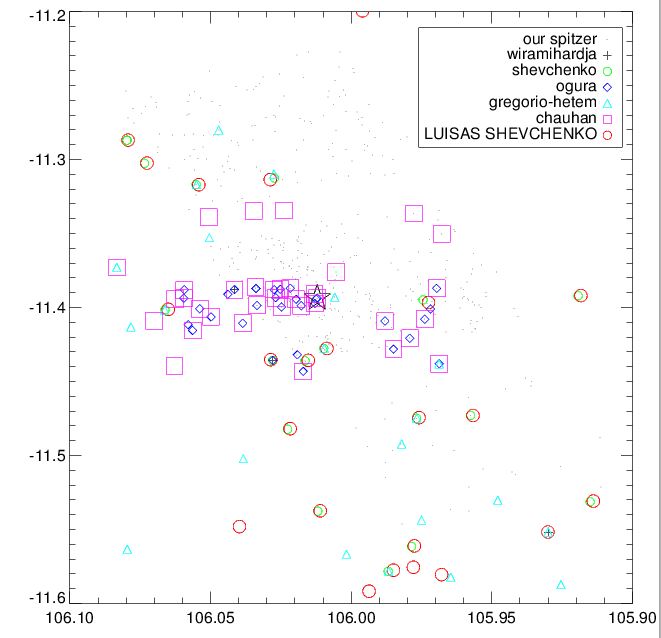Identification of Previously Known Objects on Candidate List
Contents
Friday: 08/27/2011, from Diane
Starting the conversation, here is what I sent out Friday about BRC 27.
Each SED is unique, which should mean that there are no duplications: in addition:
- Candidates 15 & 16 have the same rough coordinates, but show up as Ogura 8 & 9
- Evidently I mislabeled Ogura 21 and Ogura 22 as candidates 30 & 29.
- Candidate 29 is Ogura 21
- Candidate 30 is identified as a YSO (Chauhan) not Ogura 22 (as I had previously noted)
- Ogura 22 at 07 04 08.0 -11 23 54.75 is not on our list of candidates. (It is on the full list, but it is not one of the ones we targeted)
- Candidate 31 is NOT identified as a YSO, and is not credited to anyone I have found. this is a change from Friday
- At this point, the only candidates that are not designated as either YSO’s or stars seem to be 12, 13, and 19.
Does anybody else have an opinion on any of this?
SATURDAY, 8.28, from Diane
File:CandidateResearch brc27 dcs 27Aug.xlsx
Clarification on the referenced excel file that I sent out on Friday;
Column B: Since one of our tasks was to determine which of these objects have been previously identified, I went to Harvard's site for Simbad
http://vizier.cfa.harvard.edu/viz-bin/nph-aladin.pl
(be sure you select the Aladin applet for the US, or it will take you to France)
- npd is code for no previous designation (which is what we seem to be hunting)
For each of the candidates, I looked to see if there was any kind of identification. (You will notice that so many things are labeled, it's actually surprising to find an object that does not have one) Be sure to scroll down the the bottom of the screen to see if they have actual names; many of them are labeled Ogura.
If it says YSO, it was labeled as such on Simbad, which means somebody identified it at some point in the past... Query: That means we are confirming it?
When I could find someone to attribute a YSO to, I credited them. (see column AA) Candidates 4, 5, 11 & 28 are are not labelled on the diagram but are Ogura 3, 4, 7 & 19. Since they are in the literature, I'm not sure why they are not labeled on the image.
Objects that were cited as A's or B's, I took at face value (6,7, 10, 14, & 27). I think I understand how 27 is a blob in IRAC, but a faint point source in JHK, but why is it brighter in its R magnitude than its V magnitude? The U & B magnitudes are dimmer than the V, and I would not expect that from a B. (does that make sense?)
Candidates 29, 30, & 31 are still interesting.
Column I: anything coded yellow is something I thought was a star before I started digging. What I based that on was whether or not we had a V magnitude farther over on the table (which just happens to also be column V). I revised those opinions based on what I found in Simbad and what is in column J.
Column J: Gator DSS & 2MASS/ This brought up 5 images from DSS (information at the bottom of the column) and JHK, so I was comparing the way each object looked for the different bands.
Going through it one more time, some of my thoughts have changed, and so has the file, so it is posted above.
Today's examination has led me to the following issues:
- Is #1 really a star?
- 29 and 30 are actually a trio of objects (and I do not mean #31 as listed). I know that 31 has the same location as 30, but that is not where I find it in Simbad.
The Simbad address is 07:04:08.13 -11:23:08.7 This is a strikingly different location, and I think we need to dig further on this.
- 35 is labeled as a reflection nebula. Should we ignore it?
--Sartore 14:08, 27 August 2011 (PDT)
Mon Aug 29, from Luisa
looooooong email generalized response from luisa copied in here; see also Venn diagram attachment: File:Lmr email 29aug ppt.pdf
I did not copy in all of the subsequent mails from me, just the important bits
long email, Subject: untangling things
OK... before I start reading your mails from the last few days (which may take me a bit), let me return to the 'big picture' for a bit. Whenever tackling a big problem, I like to review both "What do we know" and "What are we trying to find". If this email is useful, I can copy this into the Wiki later.
Remember the first page of the attached? This is a Venn diagram I made for you on Friday of your visit that was meant to represent the relationship among all the various source lists we were considering. At that point in the process, we had already consolidated things into:
- All "bright enough" sources covered by the Spitzer maps (a conceptual list only)
- Sources in my catalog of extractions (I provided this)
- Sources in this general direction studied by anyone else, ever (the majority of those reported are also YSOs, but not all of them)
out of those sets, our scientific goals mean that we are aiming for a discussion of:
- YSO candidates we select from IR excess
- YSOs that others identify that do not appear to have an IR excess.
The first page in the attached was even trying to correctly represent the relative sizes of the circles in that "all bright enough sources" ought to be darn close to "sources in my catalog" and that there will be some "sources in this general direction..." not covered by the maps and some of those without IR excesses.
OK, so NOW you are going back to revisit the list of "Sources in this general direction studied by anyone else, ever" because even during your visit, we had identified some issues with that list.
On the second page of the attached, I tried to spatially represent the concepts behind what we're doing now, but I admit the circles are not as carefully constructed/laid out as the first page!
Each of these 5 papers (Ogura et al 2002, Gregorio Hetem et al. 2009, Chauhan et al 2009, Shevchenki et al 1999 and Wiramihardja et al 1986) looked in the direction of BRC27. Surely, then, they saw some of the same sources as each other, and as what we are seeing. For example, the Gregorio-Hetem survey covered a HUGE area, and we care only about a part of it. Ogura saw some of the same sources that Gregorio-Hetem did, but not all of them -- they were not covering the same areas, but even within the same area, they did not see the same sources, because one survey was x-ray driven, and one was Halpha driven. They *will* see different sources, because each survey is not infinitely deep -- the sensitivity of the surveys is limited, and as such will not see every source in this direction. Same for each other pair of papers, and our survey.
The goal here is to construct a list that is as clean as possible for each of the objects that these other folks studied, identifying which objects are truly the same between surveys, and identifying which of these objects are ones that those authors thought were young stars. We also want to carry along each of the relevant bits of information that these other authors provided -- you already know that the SED is a lot easier to identify as clearly a young object or a contaminant if there is optical data, so if the other authors reported any optical measurements, we should keep track of those and tie them to the correct object in our analysis. We should also make note of any spectral types or other relevant information. The "money question" (page 3 of the attached) is thus:
- Which objects from paper x are also seen in paper y?
and then, the next step is
- Which of these objects are seen in the IRAC data?
This would be an easy task if:
- everyone provided their original images, either as a figure or as a fits file
- everyone worked in the same coordinate system, by which i mean not just "J2000" vs "B1950" but "J2000 tied to 2MASS" as opposed to "J2000 tied to the pulsars seen by NRAO" or "J2000 as calibrated as best I can based on the HST Guide Stars I happen to see in my image" (the latter of which is what we are likely to have with the Haleakela data, by the way).
- the objects were all greater than 5 arcseconds apart from each other on the sky, such that each source that is detected was cleanly and uniquely detected in each survey.
- and, of course, that we were guaranteed a match between surveys.
Working backwards up that list...
We've already talked above about how we are not guaranteed a match between surveys, because stars are different brightnesses at different bands, and because the surveys have limited sensitivity.
You know from staring at the images that there are plenty of sources that are very close together. Even among just the YSO candidates, some are very close to each other, closer than 5 arcseconds.
If we had fabulous coordinates for everything, we could let the computer match them all up and not worry about it. But we don't. And it's not just a matter of precessing the B1950 ones to J2000 ones either - there are inherent errors in those old coordinates which will not necessarily smoothly map into a clean match to other objects.
If we had images, we could line them up by eye and identify the same objects in each frame. I don't necessarily mean "line them up in ds9" since we don't have any fits files. I mean, by comparison between images they publish and images to which you have access (IRAC, 2MASS, POSS), you can identify the objects. This is what we are going to have to retreat to, in the tough cases.
Here are some notes on these 5 papers, in no particular order:
- Gregorio-Hetem - finding charts for a few complex fields, which may or may not be in our region. J2000 coordinates tied to 2mass, though, so less worried about these. note that their discussion includes this very conceptual problem -- they are trying to tie X-ray sources to optical sources.
- Wiramihardja - no finding charts; a few very coarse-scale ones, one with just YSOs. Not a lot of help here. Also just 1950 coordinates read off a photographic plate. Likely to be large and unsystematic errors.
- Shevchenko - finding chart provided (fig 1). 1950 coordinates. big field (bigger than the region we care about).
- Ogura - finding chart provided; J2000 coordinates but not necessarily tied to 2MASS.
- Chauhan - no real finding charts provided; there are a few coarse-scale ones. J2000 coordinates tied to 2mass, though, so less worried about these.
For each of these 5 papers, we obtained a machine-readable (read as "plain text file that the computer can parse into individual numbers rather than images of numbers") version of the relevant data tables. This was either:
- obtained from the journal itself, in which case the data table is much longer than we need
- obtained from what diane did (she followed what i was telling her to do), where she typed in the coordinates of the objects in our fields from these older papers and attempted to get updated coordinates.
These tables are at the bottom of this page here: http://coolwiki.ipac.caltech.edu/index.php/BRC_Spring_work Look down under "Literature known YSOs" and then under "These papers in order of priority" and then each paper's listing has a link to files, e.g., "File:Chauhan-table3.txt".
What Diane did on my advice (see the YouTube video on that page) SHOULD work in MOST cases but did not work in every case; more on this momentarily. What she did was :
- type the 1950 coordinates into the twomass point source archive, making sure that it knows that it is 1950 coordinates.
- look at what comes back, and take the closest bright object.
Then we had 5 lists of UPDATED, HIGH QUALITY coordinates, one per paper, and we let the computer run through the list, finding the matches between papers. I then generated one file that purported to have one line per literature object, with all the relevant data on that line. But we were able to identify problems with this, in that a few sources during this process were tied to the same object, or identified in other ways as duplicates or incorrect matches.
What I recommended before that you (plural) do to get updated coordinates for targets works ON THE ASSUMPTION THAT THERE ARE NOT "TOO MANY" SOURCES NEARBY, AND THAT THE PRIOR SURVEYS, BEING SHALLOW, ARE MOST LIKELY TO MATCH TO THE BRIGHT 2MASS SOURCE. As I say, this should work in MOST cases but not ALL of them. In some cases, two distinct sources reported, e.g., two sources in Ogura were matched to the same 2MASS source during this process, and thus matched to the same IRAC source when we let the computer merge the lists.
To untangle this, we need to go back, possibly just to the duplicate sources, possibly through all of them if you can't identify with certainty which are the duplicates, and make really sure we have obtained the best possible coordinates. If the original authors are reporting more than one source within one paper, we should not consolidate them into one unless we are REALLY sure that the original authors were wrong. (This does happen; see my North American Nebula paper for examples.) Within each paper, this is what I would do:
- Go back and do the 2MASS archive search again (Go here: http://irsa.ipac.caltech.edu/applications/Gator/ -- pick 2MASS then on the next page pick 2mass point source catalog (PSC), then use that search page, making sure to specify which coordinate system in which you are working. use the coordinates from the original paper to avoid transcription errors, as opposed to any subsequent notes or xls files.)
- Look at the sources returned. Is there just one within 5-10 arcsec? that's probably your match; go on to the next source. If there is more than one, is there just one BRIGHT one within 5-10 arcsec? Is there another source from that same paper within 5-10 arcsec? If the answer to either of those questions is yes, go on to the next step.
- Go get the images in another window. Compare the images (if provided) from the original papers. We can use Finder Chart (http://irsa.ipac.caltech.edu/applications/FinderChart/) to get DSS and 2MASS images of the region where there is a confusing match. Compare this to the images provided in the papers. Identify which object is the one(s) in the paper.
- With that information, then go back to your PSC, and then use the 2MASS point source catalog to find the actual high-precision coordinates of that specific dot you have identified in the images as the match to the literature object.
Then I (or you) can take the updated high-precision lists of coordinates, merge them together, and come up with a new-and-improved list of all the previously identified objects in this region, one line per object with all the relevant information.
Then we can compare this list to our detections in IRAC. There will be some with IR excesses, and some without IR excesses.
Does this all make more sense?
Bits from other mails
Diane asked, "Are we the first to ever do SED's on these objects? (If so, that's pretty exciting, isn't it?)"
Yes, in two ways:
We're the first ones to make SEDs involving the IR for ANY of these. I don't know if Chauhan actually made SEDs or just plots, and certainly they did not do 24 um. So we're unambiguously the only ones using 24 um.
We're the first ones to DISCOVER any of the IR-selected ones not in the literature. We're the first ones EVER to care about them IN ANY WAY, so the first ones to make any plots at all, SEDs or otherwise. They might have appeared in the other people's raw data, or they may not have -- they might have just not looked like YSOs there.
This is why it's so important to really make sure that we understand which ones are in the literature. We don't want to assert that we have found new YSOs, only to have someone at the AAS meeting or someone in the journal article review process to come back and say hey, no, this is NOT a new object, you just screwed up in your literature search.
Diane asked about using Simbad's YSO classification.
BE CAREFUL because as we talked about in the Spring, Simbad is not complete nor necessarily accurate. It's good for doing an initial search or for getting pointers to the papers, but at the end of the day, you always have to go back to the original papers, and do the checks that I blathered on about in my earlier mail today. You have to compare images, finding charts, original catalogs, not just Simbad.
If it says YSO, someone at some point in Simbad tagged it as a YSO. For reasons known only to them, young stars can also be tagged: X, IR, *, Em*, BD*, red, redextreme, Y*, **, EB, HH, *inCl, *inNeb, *inAssoc, V*, V*?, pMS*, TTau*, Irregular_V*, Orion_V*, FUOr, .... the ones that really get me are YSO != *inNeb != V* != pMS* != TTau* .. there's no real distinction there. For some of the rest, you can understand historical classification, but for the most part, it's just phenomenally unclear, and linked ultimately to the whim of the person entering that particular data table. So do NOT rely on simbad for these kinds of classes either.
Remember:
- There will be objects with IR excesses we discover as YSO candidates,
- there will be objects with IR excesses we REdiscover as YSO candidates that someone else identified first, and
- there will be objects someone else identified as YSO candidates that we find to not have IR excesses.
Thursday, 9/1, from Luisa
Graphical representation of all 5 literature papers, plus ours, in BRC 27. Ogura 8 additionally indicated by large black star, since source density is high right there. 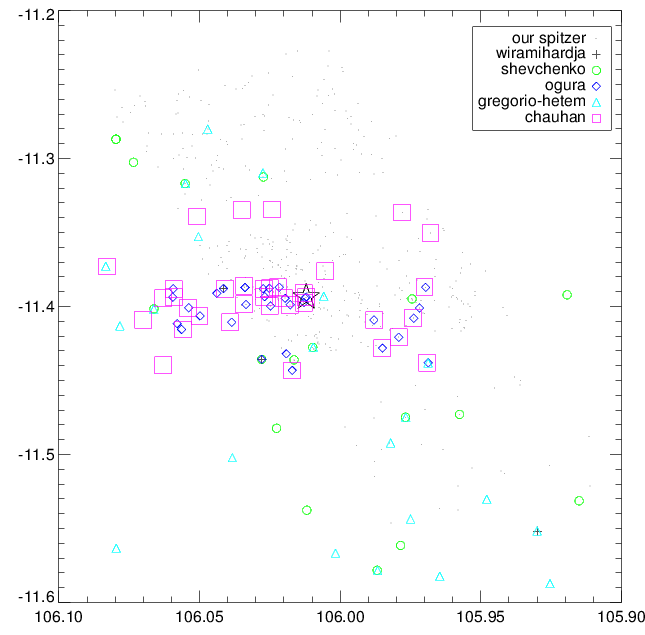
Chronicle of bugs
first bug was that the magenta squares were everything, not just chauhan objects. that's fixed in the plot above (but you can go see the earlier version of it to see my problem!)
second confusion was that i am not sure why the shevchenko list got split into two. consolidating them back into one at least for now.
third thing i found was that chauhan published their derived positions as their first ra/dec column, and then separately, later in the table, listed the 2MASS ra/dec. the accuracy of the former is not as good as the accuracy of the latter. i assumed that the former was correct, and it's really not. i've now fixed that so that the positions i'm using for chauhan are the 2mass ones. that helps a LOT with the matching up with the rest of these catalogs. this also helps a lot with the matching up between their own table 3 and table 6. now there is just one 'new' source in table 6 that does not appear earlier in table 3. there was also a bug in which some of the names from table 3 were not carried forward properly.
fourth thing i found was that two objects in gregorio that have matches in our IRAC catalog are being retained as the xray positions and not the 2mass positions. went and updated their positions (as per the youtube-documented procedure above). they're Gregorio71 and Gregorio78 in case we later have problems with them. the rest of the gregorio sources (outside of our field of view) probably have similar issues. Should we get to searching for them in WISE data, we will need to remember this uncertainty.
fifth thing i found is that ogura 21 and 23 are tied to the same 2mass source. these coordinates as given by ogura have colons (:) after them, and as such even he thought they were uncertain. For this, we will have to go back to the finding charts. anyone want to take a whack at this one?
Noted as an aside: chauhan did not apparently recognize that ogura 8/9 are apparently indistinguishable in the 2mass catalog, and listed a 2mass match to just ogura 8. have noted our match to ogura as "ogura8+9" to remind us of this. it's not clear (yet) if we can distinguish them in IRAC or not.
Next item -- made SEDs for all of these, knowing that ogura 21/23 are tied to the same 2mass source, and these are the ones with wild discontinuities between the optical and IR. Are they really correctly matched from the position as reported in the papers to the position currently listed in the catalog?
- Chauhan 107, 108, 109
- Shevchenko 90, 107
- Gregorio 74 (which is matched to a 'chauhan-anon' source) is missing 2mass data. is this really missing 2mass data? or has something else gone wonky here?
As of 4:50 pm Thursday 9/1, here is the best catalog i have : File:Litsrcs-brc27-0901-lmr.txt and the seds : File:Litsrcsseds-brc27-0901-lmr.pdf NOTE THAT there are still a lot of problems with this version!
Further update 9/2: There may be more Shevchenko or Wiramihardja sources that should be matched. The very conservative corners of the region in which we are interested are:
- -11.6 and -11.2 degrees declination (J2000) and 106.1 and 105.9 degrees RA (J2000)
- corners in sexagessimal are 07 04 24.0 -11 36 00 and 07 03 36.0 -11 12 00 in J2000, or
- 07:02:03.41 -11:31:27 and 07:01:14.96 -11:07:30.4 in B1950.
I see that 159 is listed in the paper as 07:00:21.9 -11:22:46 in B1950 coordinates. this is outside our region of interest, but to follow through this example, if I precess these to J2000, I get (assuming no proper motion): 07:02:42.66 -11:27:11.7 ... If I do a search in Gator/2mass psc I get a bang on match with 07024261-1127117 (with decimal ra, dec 105.677547 -11.453259). You can search in Gator/2mass directly in B1950 coordinates; you just need to tell it that's what you're doing, eg.,
07:00:21.9 -11:22:46 B1950
and it will report back the precessed coordinates and show the potential matches.
Remember too that we are looking for a match within a few arcseconds, like 1 to 3, depending on the accuracy of the source coordinates. It doesn't in general match exactly, but it should be close. It won't match exactly because of all the coordinate uncertainties I mentioned in my long email of Monday. for matching between 2mass and irac, the coordinates are really good, and match to within 1 arcsec or less. for matching between the first set of chauhan coordinates given in their paper and the set of coordinates corresponding to the 2mass matches, the offset is up to 2.5 arcsec. in order to assess the size of the offset, you can look at the plot that Gator gives you -- the triangle is your requested position and the green circles are the 2mass sources, ordered by distance from the requested position. you can also explicitly calculate it, but remember that you are calculating distances on a sphere, so the cosine of the declination matters. if this last statement doesn't make any sense to you, remember that, e.g., 5 seconds of time in RA on the equator is going to subtend a different angle than 5 seconds of time in RA at declination 85 degrees. The declination matters!
Wednesday, 9/7, from Chelen
Spent some time struggling with Ogura's mysterious pairsof objects and I can't seem to resolve 21/23 or 8/9 as two objects each. Hmm ... what to do next with these four (two?) bad boys?!
There were some questions about other objects matching the coordinates listed in their papers so I did some checking (i.e., used IRSA to determine if there was, in fact, an object where Chauhan or others said there was). This is what I've found...
- Chauhan 107 = slightly off ... 07h04m 03.1s -11d23m27.6s aligns very closely to 2MASS 07040314-1123275
- Chauhan 108 = ??? ... 07h03m54.7s -11d20m11s Equ J2000 does not have a 2MASS counterpart (according to GATOR) but it appears to have one, if you look at IRSA Finder Charts
- Chauhan 109 = ??? ... 07h03m52.3s -11d21m1.1s Equ J2000 does not have a 2MASS counterpart according to GATOR and not seen on IRSA Finder Charts
- Shevchenko 90 = ??? ... 07h01m32.6s -11d19m17s Equ B1950 ... which precesses to 07h 03m 53.42s -11d 23m 47.8s in J2000 has two possible 2MASS counterparts ... 07035350-1123506 and 07035387-1123415 (GATOR) and looking at the 2MASS and DSS Finder charts there are two blobs, virtually indistinguishable
- Shevchenko 107= ... 07h01m46.0s -11d14m17s Equ B1950 ... which precesses to TYPO aligns with 2MASS TYPO and looks reasonable on the IRSA Finder Charts, as well
- Gregorio 74 = match ... 7h 4m1.40s -11d23m35.02s matches with 2MASS 07040138-1123346
- Are there other glaringly obvious ones that we want to check? I can run through the rest of the "YES" list, if that would help.
Wednesday, 9/7, from Luisa
For our conversation later today... Here is an example of a 'clean' source, which is Ogura 22 (2MASS 07040803-1123547), in the Finder Chart results, so 2MASS JHK then 5 flavors of POSS (blue, red, poss2 blue, poss2 ir, poss2 red). The order doesn't matter as much as the shape of the blob, especially in the first three images, because those are 2MASS. (Ogura 22 is indicated with a red circle.)
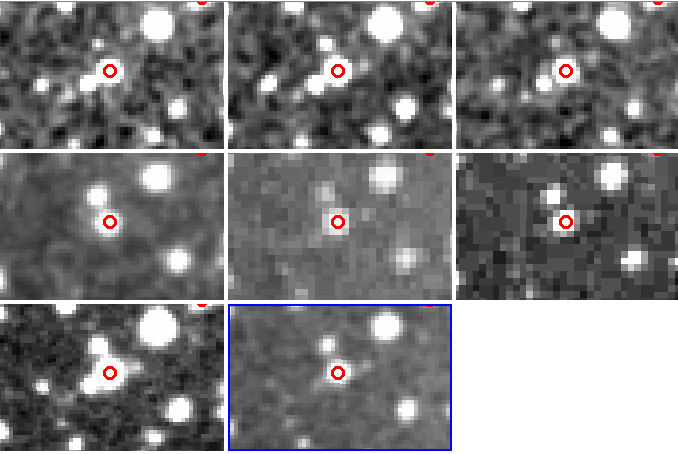 This one is supposed to have a clean match, and it does -- that is a nice, circular, relatively isolated source at 2MASS bands.
This one is supposed to have a clean match, and it does -- that is a nice, circular, relatively isolated source at 2MASS bands.
OK, now, one of our problem children -- Ogura 8 and 9 -- is here.
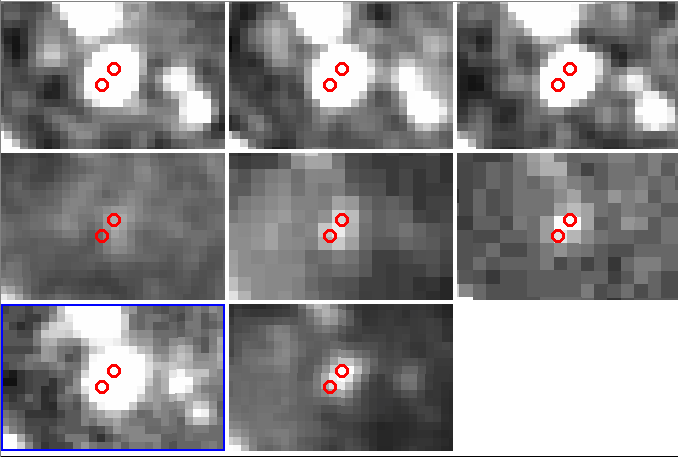 The red circles are the positions as given by Ogura. Note that this is barely not a circular source in the 2mass frames (the first 3), and less so in the optical frames (the rest of them). It is ever so slightly extended in the same orientation as the two sources given by Ogura. The 2MASS point source catalog didn't recognize this as multiple point sources, so it is only barely extended, but it is. Here is a view of just the J band image with the 2mass point source catalog overlaid.
The red circles are the positions as given by Ogura. Note that this is barely not a circular source in the 2mass frames (the first 3), and less so in the optical frames (the rest of them). It is ever so slightly extended in the same orientation as the two sources given by Ogura. The 2MASS point source catalog didn't recognize this as multiple point sources, so it is only barely extended, but it is. Here is a view of just the J band image with the 2mass point source catalog overlaid. 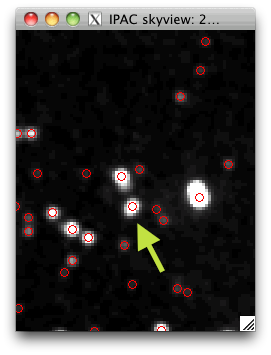 It might be easier at this scale and stretch to see that this is not a perfect point source like many of the other sources here. It has a slight extension beyond the red circle. (Note that the two other nearby sources are ALSO incorrectly identified as single point sources; the chain of three to the lower left are really point sources.) We will have to note all of this information we have learned about Ogura8+9 in our paper, and say that we can't resolve Ogura 8+9, that 2MASS can't either, and that we are measuring the net (combined) SED from both sources togther.
It might be easier at this scale and stretch to see that this is not a perfect point source like many of the other sources here. It has a slight extension beyond the red circle. (Note that the two other nearby sources are ALSO incorrectly identified as single point sources; the chain of three to the lower left are really point sources.) We will have to note all of this information we have learned about Ogura8+9 in our paper, and say that we can't resolve Ogura 8+9, that 2MASS can't either, and that we are measuring the net (combined) SED from both sources togther.
The other one of our problem children -- Ogura 21 and 23 -- is here.
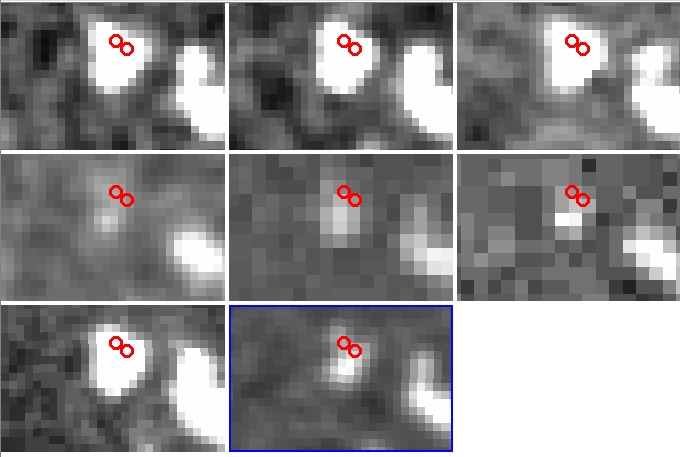 Again, the red circles are the positions as given by Ogura. This is even more of a complicated situation than Ogura 8+9, because there is a THIRD source polluting the photometry here.
Again, the red circles are the positions as given by Ogura. This is even more of a complicated situation than Ogura 8+9, because there is a THIRD source polluting the photometry here.
IN this case, though, look -- the 2mass point source catalog does successfully resolve all three.
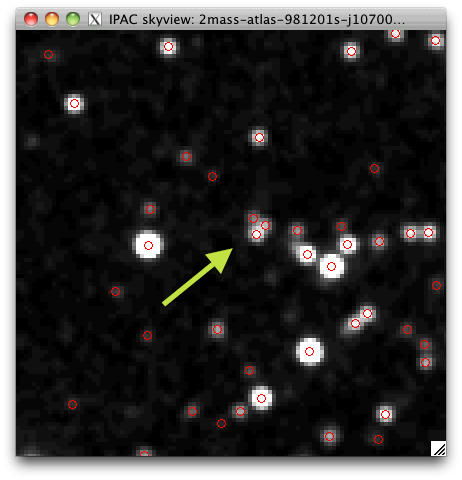 This is the J band image with the 2mass point source catalog overlaid. It sees (and distinguishes) all of the sources. The top one of the trio is 07040816-1123097, the middle one is 07040797-1123114, and the bottom one is 07040812-1123137. Which ones of these should be correctly matched to Ogura 21 or 23? REALLY hard to tell. We might be able to make a guess by looking at the POSS images and seeing which two are brighter in the optical. But there is not a lot of help there, as the brighter source in the optical is the lower one of the three! Has Ogura flagged this pair for any sort of special consideration in his paper? We will definitely need to make a note of this in our paper, and include an analysis of the properties of all three of these objects.
This is the J band image with the 2mass point source catalog overlaid. It sees (and distinguishes) all of the sources. The top one of the trio is 07040816-1123097, the middle one is 07040797-1123114, and the bottom one is 07040812-1123137. Which ones of these should be correctly matched to Ogura 21 or 23? REALLY hard to tell. We might be able to make a guess by looking at the POSS images and seeing which two are brighter in the optical. But there is not a lot of help there, as the brighter source in the optical is the lower one of the three! Has Ogura flagged this pair for any sort of special consideration in his paper? We will definitely need to make a note of this in our paper, and include an analysis of the properties of all three of these objects.
The next one on the list of problem children of a different sort was Chauhan 107. This one was identified as odd based on the shape of the SED, where it was discontinuous between the optical and IR. Here is the finder chart set of images (first three are two mass): 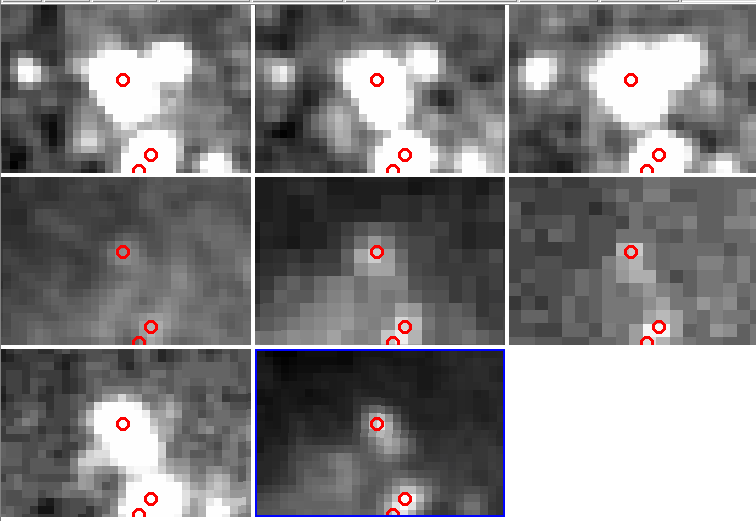 and just the Jband with the 2mass point source catalog overlaid:
and just the Jband with the 2mass point source catalog overlaid: 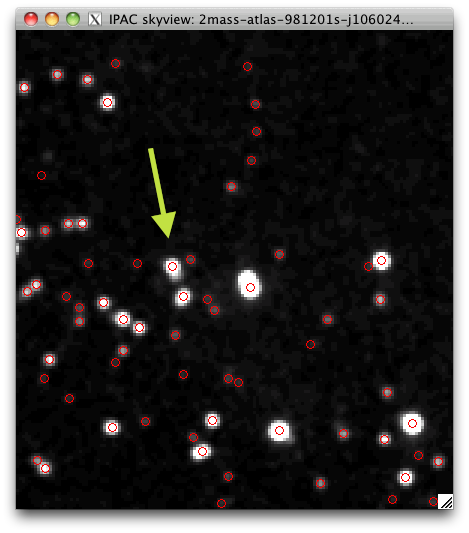 . What do you think is going on? (Do you recognize this field of view?)
. What do you think is going on? (Do you recognize this field of view?)
Specifically on the stuff Chelen sent above:
Chelen wrote: There were some questions about other objects matching the coordinates listed in their papers so I did some checking (i.e., used IRSA to determine if there was, in fact, an object where Chauhan or others said there was). This is what I've found ...
remember that for Chauhan 107, 108, 109 and Shevchenko 90, 107, the reason i've flagged them for checking is that the optical and their IR seds were discontinuous. We have identified 2mass matches for all of them, but the issue is whether or not that match is right. the matches are listed in the catalog i posted last thursday.
Chauhan 107 = slightly off ... 07h04m 03.1s -11d23m27.6s aligns very closely to 2MASS 07040314-1123275
that's what i get, but when you look at the finder charts (above!), we may have a better sense of what is going on. more on this later today.
Chauhan 108 = ??? ... 07h03m54.7s -11d20m11s Equ J2000 does not have a 2MASS counterpart (according to GATOR) but it appears to have one, if you look at IRSA Finder Charts
Not sure what oyu mean by "does not have a counterpart" as I get that it's matched to 07035465-1120110. that seems to match in position to what you have.
Chauhan 109 = ??? ... 07h03m52.3s -11d21m1.1s Equ J2000 does not have a 2MASS counterpart according to GATOR and not seen on IRSA Finder Charts
Not sure what you mean by "does not have a counterpart" as I get that it's matched to 07035228-1121009. this seems to match in position. do you really not see it in the finder chart?
Shevchenko 90 = ??? ... 07h01m32.6s -11d19m17s Equ B1950 ... which precesses to 07h 03m 53.42s -11d 23m 47.8s in J2000 has two possible 2MASS counterparts ... 07035350-1123506 and 07035387-1123415 (GATOR) and looking at the 2MASS and DSS Finder charts there are two blobs, virtually indistinguishable
Ah, this is good stuff! this is the sort of thing we are looking for! we will need to try matching it to its friend and see if that yields a better SED. We have it currently matched with 07035387-1123415, so we need to try the other one.
Shevchenko 107= ... 07h01m46.0s -11d14m17s Equ B1950 ... which precesses to TYPO aligns with 2MASS TYPO and looks reasonable on the IRSA Finder Charts, as well
Excellent, this may be one of the ones from shevchenko whose 'updated' position was wrong. i have that it matched to 07040654-1118448 which is rather hugely offset.
Gregorio 74 = match ... 7h 4m1.40s -11d23m35.02s matches with 2MASS 07040138-1123346
ok, this one was in the list of things to check because it appeared to have been missing 2mass data in its SED. I too have it matched to 07040138-1123346. All three measurements in here are tagged photometric quality 'E' (A is good, E is .. not), so something choked in the 2mass catalog when it was measuring the photometry at this position.
Wednesday 9/7 scorecard
Ogura 8/9 - found as a problem because tied to the same 2mass source. these two turn out to be indistinguishable in the 2mass catalog, and will be tagged in our catalog as "ogura8+9" to remind us of this. it's not clear (yet) if we can distinguish them in IRAC or not.
Ogura 21/23 - found as a problem because tied to the same 2mass source. These are distinguishable in the 2mass catalog, but fluxes likely contaminated by a 3rd source. Need to tag them in our catalog and add in this third source. it's not clear (yet) if we can distinguish them in IRAC or not.
Chauhan 107 - found as a problem because SED discontinuous between vis and IR. more than one source, or extended emission, can be seen in the 2mass image. photometry probably suspect because of this. unclear what exactly is being measured. will have to note this in our discussion of this source.
Chauhan 108 - found as a problem because SED discontinuous between vis and IR. still pending
Chauhan 109 - found as a problem because SED discontinuous between vis and IR. still pending
Shevchenko 90 - found as a problem because SED discontinuous between vis and IR. Chelen finds an apparent binary here. "two possible 2MASS counterparts ... 07035350-1123506 and 07035387-1123415". Either the optical or the IR could be measuring net (merged) fluxes, or if they both resolve the pair, we could be matching to the wrong one of the two. Try matching it to the other position, and re-make the SED, and see if it improves matters.
Shevchenko 107 - found as a problem because SED discontinuous between vis and IR. Chelen matches it to TYPO. i have that it matched to 07040654-1118448 which is rather hugely offset. Will need to update the master shevchenko catalog (see below) and re-match, re-make SEDs, re-check this.
Gregorio 74 - found as a problem because appears to be missing 2mass data. Turns out 2mass photometry is flagged as bad. adding it back in to the catalog, but with large errors. remember this and check the SED for internal consistency when we re-construct the SEDs.
Everything in the region we care about from Shevchenko - found as a problem because spot checks reveal some objects matched to wildly different objects (eg., Shevchenko 107). still pending
Everything in the region we care about from Wiramihardja - found as a problem because spot checks reveal some objects matched to wildly different objects. still pending
Saturday, September 10, 2011
From Team Illinois
I verified Wiramihardja 19-34 close to the box made by 07 02 0341 -11 31 27 and 07 01 1496 -11 30 40. The stars that were close to the box were Wirmaihardja 20, 22, 23, 27, 29, 31, 33, and 34. Using the IRSA general catalog search, I entered the right ascension and declination of the stars in the 1950 catalog and compared 2MASS designations from the 1950 catalog to the ones in J2000 from IRSA for the stars that matched the right ascension and declination from the 1950 catalog.
Wiramihardja 20— one star at coordinates and 2MASS designation is the same for 1950 and J2000
Wiramihardja 22— one star at coordinates and 2MASS designation is the same for 1950 and J2000
Wiramihardja 23— one star at coordinates and 2MASS designation is the same for 1950 and J2000
Wiramihardja 27— one star at coordinates, but found that 2MASS designation is 07042617-1131287 in 1950 and 07042676-1131333 in J2000
Wiramihardja 29— one star at coordinates and 2MASS designation is the same for 1950 and J2000
Wiramihardja 31— two stars near coordinates, but closer star, which is labeled 2, has the same 2MASS designation for 1950 and J2000
Wiramihardja 33— one star at coordinates and 2MASS designation is the same for 1950 and J2000
Wiramihardja 34— one star at coordinates, but found that 2MASS designation is 07025641-1106152 in 1950 and 07051685-1110437 in J2000
--Fagan 09:19, 10 September 2011 (PDT)
I verified Sevchenko’s 82,84,90,92,99,100,102,103,107,111,114,115,117,88,93,116,117,162. first of all due to the fact these coordinates were taken in 1950 I had to change then into the J200 coordinates because stars do move. All Sevchenko’s stars had the same 2MASS designation. Except
• Sevchenko 90 did not have the same designation, its J200 coordinates are 07 03 53.42 -11 23 47.8
I went back into and verified all of his coordinates in Sevchenko’s original paper. They all match the original paper; however, I did find some that could be possible missed stars.
• Sevchenko 161- 07 01 46.1 -11 28 36 possible missed star
• Sevchenko 89- 07 01 31.7 -11 30 19 possible missed star
• Sevchenko 95- 07 01 37.9 -11 30 59 possible missed star
• Sevchenko 109- 07 01 48.9 -11 28 21 possible missed star
--Rameswaram 09:45, 11 September 2011 (PDT)
Response from Luisa
HI team Illinois - Do you remember why, exactly, we're doing this? The purpose is to get updated coordinates for these objects based on how they compare to the 2mass data. The problem is two fold: the original folks were working off of photographic plates, so their astrometry (the precision with which they know their coordinates) is limited, and moreover they were working in 1950 coordinates. Now we need to work in 2000 coordinates. Review with Ms. Linahan what the difference is between those coordinate systems. REMINDER: THE STARS ARE NOT MOVING. The coordinate system is moving, not the stars. (Well, the stars may really be moving, but we don't have that information, and the size of any such motion will be on the order of a tenth of an arcsec or less; the change due to coordinates is much greater.) An analogy as an aside: here is an example. Through Google Maps, I can see that there is a Baskin Robbins near your school. I can give you the position of that Baskin Robbins in any of a number of ways:
- 346 North Lake St, Mundelein
- 8 long blocks roughly west of your school
- 4 minutes west of your school (if you drive)
- latitude 42.269711, longitude -88.004308
Are the coordinates different in these systems? Yes, but they are pointing to the same physical location. Is the Baskin Robbins really moving? No. That is what is going on here in BRC27. The B1950 coordinates and the J2000 coordinates are different coordinate systems, and we are trying to translate one into the other, e.g., translate "346 North Lake St, Mundelein" into "latitude 42.269711, longitude -88.004308". The added complication here is that the previous authors were not working in a very precise coordinate system. It's as if someone said "There's an ice cream store on Lake, south of Loch Lomond." Your first step might be to identify all the ice cream stores on Lake, south of Loch Lomond, and then, having identified this one, then obtain its address in house numbers (346 North Lake St) and then converted that to lat/long (42.269711, -88.004308) for telling someone else (someone who thinks in lat/long) where this thing is. (End analogy.)
From what you transcribed into the wiki (you may have had more notes that you did not copy into the wiki), what I understand you to have written is that (a) that the objects had the same coordinates in 1950 as they do in 2000, and (b) you did not tell me what the 2mass match was. Since the goal of this is to get the 2MASS match, it is hard for me to find the 2MASS match if you do not tell me what it is. (In the analogy above, you told me "yep, there's an ice cream store on Lake, south of Loch Lomond", but you didn't tell me where it is more precisely than that.) And, as to the other statement, let's investigate whether the objects could possibly have the same position in 1950 coordinates as they do in 2000.
Now, here is a plot of all the positions (in red) as they exist in the original 1950 coordinates from Shevchenko, and the positions precessed to 2000 coordinates (in black). Look how big that shift is.
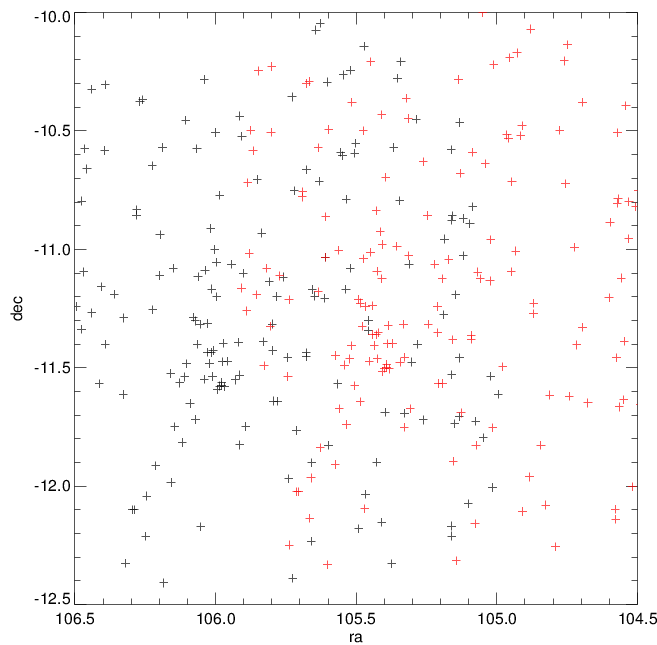
If you can't see which objects move where, try this: I've drawn lines between the same objects here.
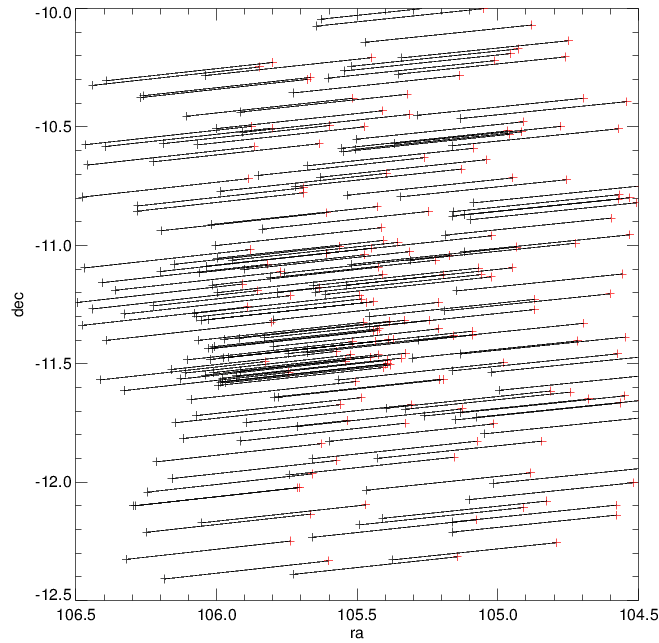
The axes here are in DEGREES. According to my calculations, one of these objects moves, on average, SIX TENTHS OF A DEGREE IN RA ALONE. How many 2MASS sources are in this region? Thousands, at least. There is no way that the match to the object could be the same in 1950 and 2000 coordinates.
Now, what you could have meant was: if you enter 1950 coordinates and have the 2mass machine precess it to 2000, and note the results, and then if you enter the precessed 2000 coordinates, you get the same results. That SHOULD be true. The precession should be unique and consistent, and it doesn't matter if you let the 2MASS machine do the precession or you do it in some other way. But that doesn't seem to have been what you wrote down, at least.
So, what happened? Do you still have a list that looks like an updated version of our original data file (e.g., File:Shevchenko stellar.txt), with one object per line that has at the very least the old name and the new coordinates? We also need (as per the original instructions on the bottom of the BRC Spring work page) to have any additional photometric data also recorded. The Shevchenko paper also reports V, R, U, and B magnitudes. These will also be useful for adding to the SEDs!
Breck Work on Previously Known Objects
Attached is the composite spreadsheet of the Bugs List. After precessing all the Wiramihardja and Shevchenko objects to J2000 coordinates, it seems that most are no longer within our boundaries of BRC 27.
--CJohnson 13:07, 11 September 2011 (PDT)
Hi team Minnesota - OK, I'm confused by what you've done too. Here, I've taken the same plot from above and overplotted my precessed values of the Shevchenko catalog. I get 21 (TWENTY-ONE!), 22 if you count the guy half off this plot on the top, objects from Shevchenko in this field of view, which should match the region where we were looking. Admittedly, only about 8 should be in the Spitzer maps; I gave you before the boundaries of this plot rather than the boundaries of the Spitzer map because the box is rectangular and the Spitzer map is not. (The three Wiram* sources here are still the same ones I had before; I haven't done this same exercise with those data tables.)
Some of these are close to the position that we had down before for them, some are not, and some are totally new.
So, what happened? Was it just the last step where you identified which objects are still in the BRC 27 region? Which coordinate system were you working in for making that determination?
